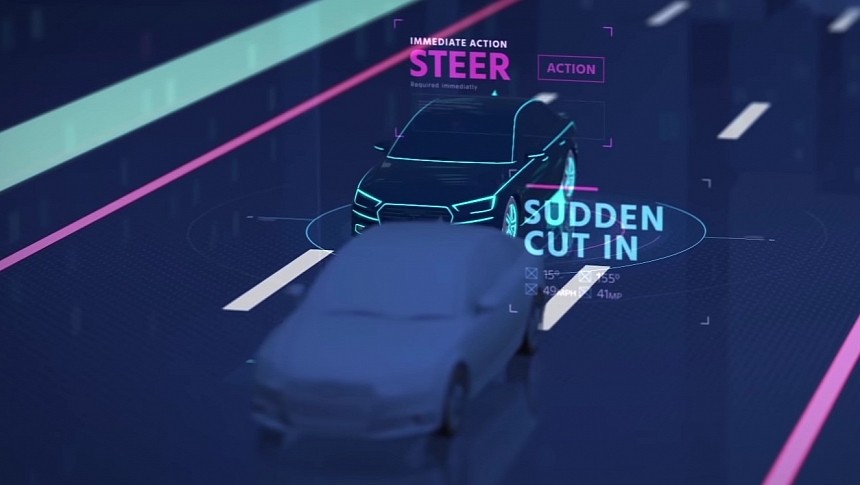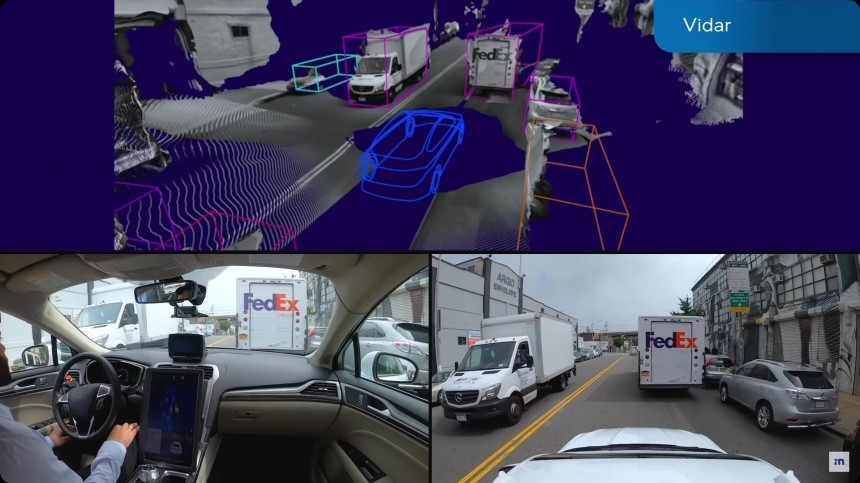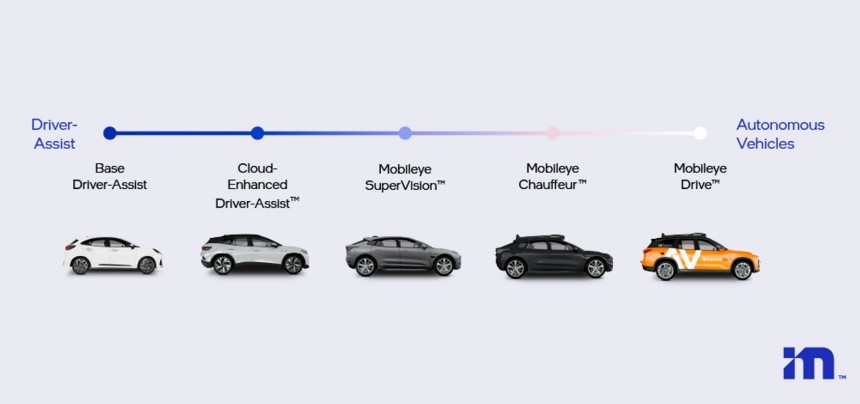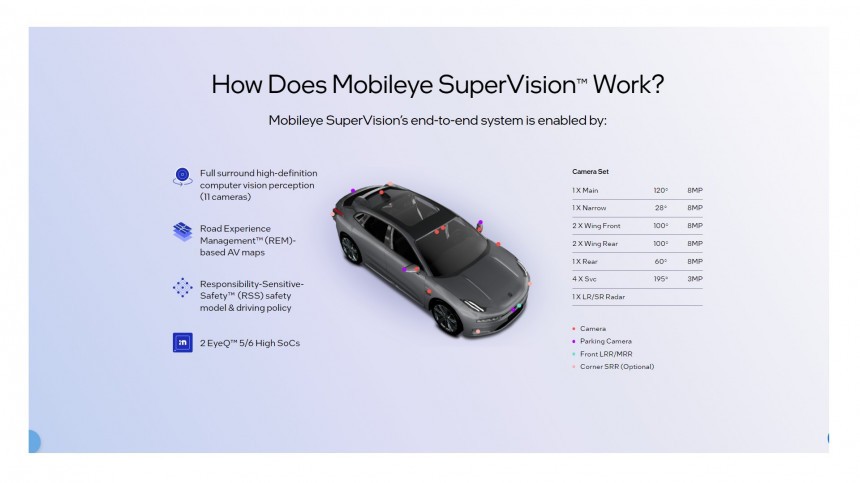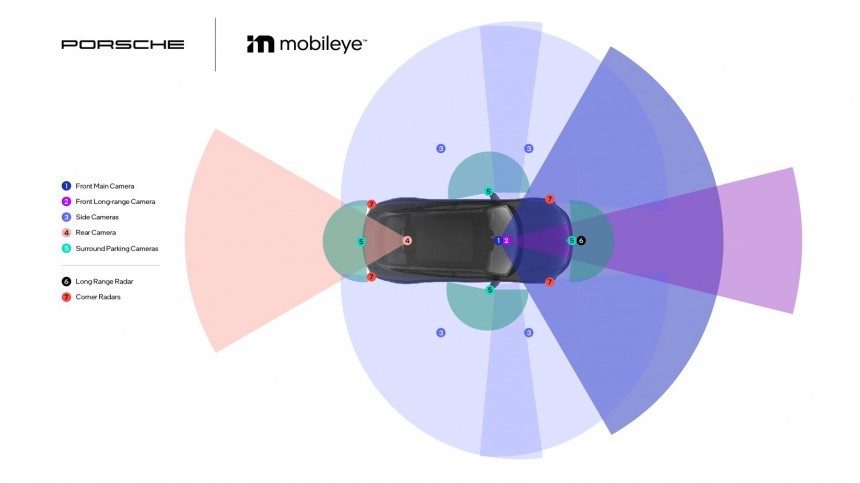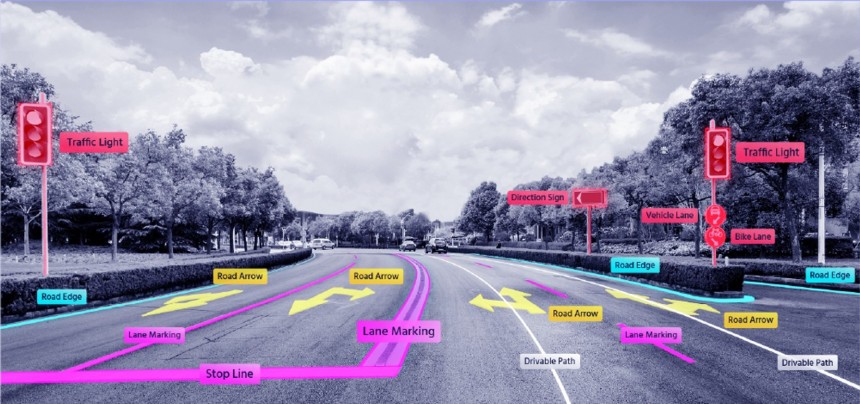Porsche takes a first and crucial step towards its self-driving future and partners with Mobileye to implement SuperVision driver assistance in upcoming vehicles. The tech enterprise has developed a reality-check sensors array for automobiles, consisting of 11 cameras and radars that provide a surround-monitoring and sensing aid to the human behind the steering wheel.
Mobileye is a company founded in Israel in 1999, and from 2017 is part of Intel – the acquisition alone set a historic milestone; at $15.3 billion, it became the largest Israeli acquisition deal ever. The technology developer has been working with other automotive greats – Audi, BMW, General Motors, Honda, Nissan, and Tesla – for their versions of self-driving platforms.
Porsche gets the most advanced driver-assist system Mobileye offers. This "hands-off" navigation solution can guide vehicles through various traffic and road scenarios. With SuperVision, the car engages traffic and makes decisions without the driver actively controlling the vehicle.
That's not to say the person in charge of the automobile – the driver – is utterly dismissed from their responsibilities. The "eyes-on" algorithm implies that the human behind the steering wheel is always focused on the road, ready to overtake should the AI-backed Advanced Driver Assistance System (ADAS) fail.
More than 60,000 vehicles worldwide benefit from the Mobileye SuperVision functionalities (out of over 135 million cars equipped with the company's assist tech). The vehicles can perform lane changes and point-to-point navigation (with adaptive cruise control) and are always fully aware of their surroundings.
Ten video cameras provide a high-definition surroundings perception to a computer that decides the best action based on the visual inputs. Additionally, a pair of radars offer a different perception of the car's environment for 360°-field-of-view monitoring. A test drive from a SuperVision-equipped vehicle in New York traffic is shown in the second video.
But it gets even better. This is where Mobileye's genius software architecture comes to play. From driving school to permanently giving up the keys to a designated driver, humans are taught to behave while motoring. We can all safely engage in traffic using a handful of principles based on common sense and physical ability.
How often have you heard the phrase, "Maintain a safe distance from the vehicle in front of you?" How often has someone explained what "safe distance" translates to in standard measurement units? At 62 mph (100 kph), how far back do I need to be to avoid a collision with the car that cuts me off on the highway?
Don't rush for a pen and paper or even a computer because the equation is far too complex to solve in a split-second. But we rely on road experience to stay safe after spending considerable time behind the wheel.
Mobileye develops algorithms that assemble a mathematical model of all the human-centered transportation contexts (that are otherwise subjective). Again, returning to the previous example, we must factor in how well our automobile brakes, what the road is like, what weather the incident would occur, and so on. Not to mention reflexes, reaction times, and self-control.
The Intel Corp. company – Mobileye – has formulated five mathematical models of the rules of autonomous driving behavior - check the video for details. Called Responsibility-Sensitive Safety (RSS), the simple statements are nothing new to anyone. "Don't hit the car in front of you," "Don't cut in recklessly," "Right of way is given, not taken," "Be cautious in areas with limited visibility," and "If you can avoid a crash without causing one, you must."
These deceptively straightforward enunciations are very familiar to us humans - see the first video for details. But not to Artificial Intelligence, and AI only understands math, and to this day, there's no equation for recklessness.
Imagine the following scenario: at a crossroads, a self-driving car encounters a classic machine from the 1970s. The high-tech machine has the right of way, yet the old-timer disobeys the traffic signs and goes first. What rules must the autonomous car follow?
It is obvious (for us humans) that it needs to avoid the collision. But the software declares it can go first. What's the solution? Update the software to make it context-responsive. This is where Road Experience Management (a seven-step data aggregation process also developed by the Israeli-founded company) takes over.
It uses real-time input from vehicles equipped with Mobileye tech to deliver "the wisdom of the crowd" to every similarly equipped car, at all times, uninterrupted. This data-sharing process – that I've vastly oversimplified for ease of reading – is the key to making a car "understand" its surroundings along any route.
First, all cars collect information from the road as they drive – no matter how volatile the driving conditions might be, like a temporary blockage or other specifics. The data is then segregated into relevant categories and uploaded to the cloud.
A real-time computerized model is then constructed for every road element (like width and length, traffic signs, and driving behavior adopted by other cars at specific points and moments). Finally, a "roadbook" is created, containing all information regarding the road infrastructure. This bank of real-time data is continuously updated and accessed simultaneously by all contributing cars.
Eventually, when sufficient data is collected, the cars can move to the Eyes-Off, Hands-Off driving model, becoming fully autonomous. This means the drivers are no longer mandated to pay close attention to the road and the vehicle's performance. Of course, they can still do so, but the car won't need a superseding human authority to oversee its operations.
Porsche will include Mobileye SuperVision as a primary element in its ADAS platform - including critical driver monitoring systems. However, putting the system on standby during specific driving sessions of Porsche's most performing creations would benefit everyone. Otherwise, the Mobileye databank might end up with 200-mph speeds and tire-vaporizing fun as regular input from high-octane purists.
Porsche gets the most advanced driver-assist system Mobileye offers. This "hands-off" navigation solution can guide vehicles through various traffic and road scenarios. With SuperVision, the car engages traffic and makes decisions without the driver actively controlling the vehicle.
That's not to say the person in charge of the automobile – the driver – is utterly dismissed from their responsibilities. The "eyes-on" algorithm implies that the human behind the steering wheel is always focused on the road, ready to overtake should the AI-backed Advanced Driver Assistance System (ADAS) fail.
Ten video cameras provide a high-definition surroundings perception to a computer that decides the best action based on the visual inputs. Additionally, a pair of radars offer a different perception of the car's environment for 360°-field-of-view monitoring. A test drive from a SuperVision-equipped vehicle in New York traffic is shown in the second video.
But it gets even better. This is where Mobileye's genius software architecture comes to play. From driving school to permanently giving up the keys to a designated driver, humans are taught to behave while motoring. We can all safely engage in traffic using a handful of principles based on common sense and physical ability.
Don't rush for a pen and paper or even a computer because the equation is far too complex to solve in a split-second. But we rely on road experience to stay safe after spending considerable time behind the wheel.
Mobileye develops algorithms that assemble a mathematical model of all the human-centered transportation contexts (that are otherwise subjective). Again, returning to the previous example, we must factor in how well our automobile brakes, what the road is like, what weather the incident would occur, and so on. Not to mention reflexes, reaction times, and self-control.
These deceptively straightforward enunciations are very familiar to us humans - see the first video for details. But not to Artificial Intelligence, and AI only understands math, and to this day, there's no equation for recklessness.
Imagine the following scenario: at a crossroads, a self-driving car encounters a classic machine from the 1970s. The high-tech machine has the right of way, yet the old-timer disobeys the traffic signs and goes first. What rules must the autonomous car follow?
It is obvious (for us humans) that it needs to avoid the collision. But the software declares it can go first. What's the solution? Update the software to make it context-responsive. This is where Road Experience Management (a seven-step data aggregation process also developed by the Israeli-founded company) takes over.
First, all cars collect information from the road as they drive – no matter how volatile the driving conditions might be, like a temporary blockage or other specifics. The data is then segregated into relevant categories and uploaded to the cloud.
A real-time computerized model is then constructed for every road element (like width and length, traffic signs, and driving behavior adopted by other cars at specific points and moments). Finally, a "roadbook" is created, containing all information regarding the road infrastructure. This bank of real-time data is continuously updated and accessed simultaneously by all contributing cars.
Porsche will include Mobileye SuperVision as a primary element in its ADAS platform - including critical driver monitoring systems. However, putting the system on standby during specific driving sessions of Porsche's most performing creations would benefit everyone. Otherwise, the Mobileye databank might end up with 200-mph speeds and tire-vaporizing fun as regular input from high-octane purists.
